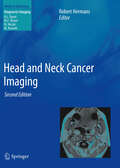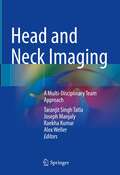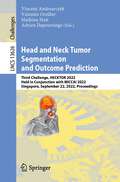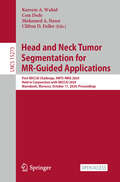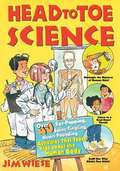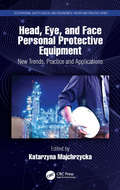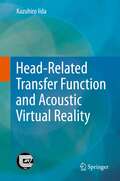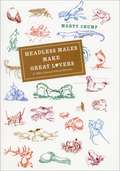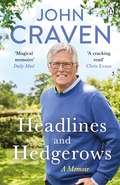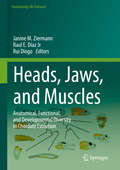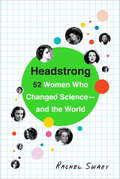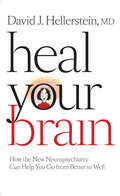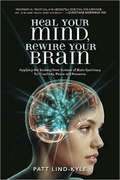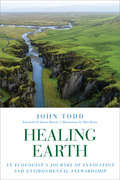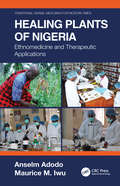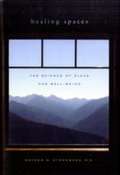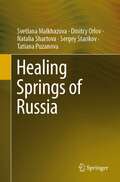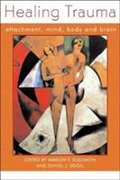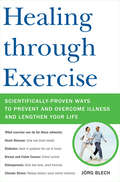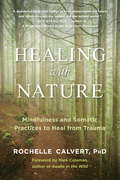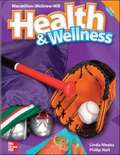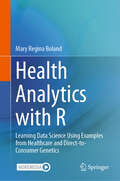- Table View
- List View
Head and Neck Cancer Imaging
by Robert HermansImaging is crucial in the multidisciplinary approach to head and neck cancer management. The rapid technological development of recent years makes it necessary for all members of the multidisciplinary team to understand the potential applications, limitations, and advantages of existing and evolving imaging technologies. It is equally important that the radiologist has sufficient clinical background knowledge to understand the clinical significance of imaging findings. This book provides an overview of the findings obtained using different imaging techniques during the evaluation of head and neck neoplasms, both before and after therapy. All anatomic areas in the head and neck are covered, and the impact of imaging on patient management is discussed in detail. The authors are recognized experts in the field, and numerous high-quality images are included. This second edition provides information on the latest imaging developments in this area, including the application of PET-CT and diffusion-weighted magnetic resonance imaging.
Head and Neck Imaging: A Multi-Disciplinary Team Approach
by Joseph Manjaly Taranjit Singh Tatla Raekha Kumar Alex WellerThis book provides a practically applicable guide to the all the different imaging modalities used in the diagnosis and management of ENT & Head and Neck patients. It bridges the gap in understanding between surgeons treating ENT & Head and Neck conditions and radiologists who oversee the process of scan requests, interpretation and delivering reports that best inform the subsequent management. Chapters cover a variety of sub-specialist areas including plain films, ultrasound, computed tomography (CT), magnetic resonance imaging (MRI), auditory implantation, paediatrics, head and neck cancer, trauma, three dimensional (3D) reconstruction and rehabilitation including swallow. This book facilitates surgeons and radiologists to further develop their understanding of each other’s perspectives on clinical decision-making and appropriately interpreting the outputs from a range of imaging modalities. Head and Neck Imaging: A Multi-Disciplinary Team Approach is a resource well-suited to all trainees, residents, consultants who use these techniques to treat patients with head and neck symptoms. Furthermore, it is vital for those individuals preparing for exams in disciplines such as ear nose and throat, maxillofacial surgery and radiology.
Head and Neck Tumor Segmentation and Outcome Prediction: Third Challenge, HECKTOR 2022, Held in Conjunction with MICCAI 2022, Singapore, September 22, 2022, Proceedings (Lecture Notes in Computer Science #13626)
by Vincent Andrearczyk Valentin Oreiller Adrien Depeursinge Mathieu HattThis book constitutes the Third 3D Head and Neck Tumor Segmentation in PET/CT Challenge, HECKTOR 2022, which was held in conjunction with the 25th International Conference on Medical Image Computing and Computer-Assisted Intervention, MICCAI 2022, on September 22, 2022.The 22 contributions presented, as well as an overview paper, were carefully reviewed and selected from 24 submissions. This challenge aims to evaluate and compare the current state-of-the-art methods for automatic head and neck tumor segmentation. In the context of this challenge, a dataset of 883 delineated PET/CT images was made available for training.
Head and Neck Tumor Segmentation for MR-Guided Applications: First MICCAI Challenge, HNTS-MRG 2024, Held in Conjunction with MICCAI 2024, Marrakesh, Morocco, October 17, 2024, Proceedings (Lecture Notes in Computer Science #15273)
by Kareem A. Wahid Cem Dede Mohamed A. Naser Clifton D. FullerThis Open Access book constitutes the refereed proceedings of the First MICCAI Challenge, HNTSMRG 2024, Held in Conjunction with MICCAI 2024, in Marrakesh, Morocco, on October 17, 2024. The 20 full papers and 1 overview paper included in this volume were carefully reviewed and selected from a total of 21 submissions. The HNTS-MRG 2024 Challenge focuses on advancing clinical workflows by leveraging artificial intelligence (AI) for automated segmentation of tumor regions in multi-timepoint MRI scans.
Head to Toe Science: Over 40 Eye-popping, Spine-tingling, Heart-pounding Activities That Teach Kids About The Human Body
by Jim Wiese Tina Cash-WalshUntangle the Mystery of Human Hair! Listen to a Heart Throb! Sniff Out Why Stinky Feet Stink! SCIENCE THAT REALLY GETS UNDER YOUR SKIN! Explore the amazing human body, from the hair on your head to your stinky feet * Smell like a salmon * Build a balloon intestine * Mix up a batch of fake blood * Crack your genetic code How much air do your lungs hold? How are your bones like a roll of toilet paper? Where does all your old dead skin go? How can you figure out how tall a person is from the size of his or her feet? You ll find out the answers in Head to Toe Science. More than 40 fun, easy-to-do activities using ordinary products found around your house let you discover the wonders of your body from top to bottom, inside and out your brain, your bones, your digestive, circulatory, and nervous systems, and much more!
Head, Eye, and Face Personal Protective Equipment: New Trends, Practice and Applications (Occupational Safety, Health, and Ergonomics)
by Katarzyna MajchrzyckaHead, Eye, and Face Personal Protective Equipment: New Trends, Practice, and Applications presents protective equipment in the context of the latest design trends, materials, and technologies. It informs the reader using basic safety principles to avoid issues with commonly used personal protective equipment (PPE), such as helmets and eye and face protectors. It provides the latest design trends in eye and face protectors to avoid optical hazards and for use in variable lighting conditions. Features: • Fills the gap on current solutions of PPE and occupational safety • Educates in reducing risk connected with using industrial safety gear • Helpful to optometrists in the selection of eye protection for people with visual impairments • Instructs the reader on choosing smart materials and safety products • Provides best practices for checking the technical condition of the equipment This book is essential for the safety professional and medical experts in the field. It provides an interdisciplinary approach to personal protective equipment using new technologies in the field. "The monograph Head, Eye, and Face Personal Protective Equipment - New Trends, Practice and Applications is a complementary and thoughtful but selected compilation of the most relevant information concerning protective helmets as well as eye and face protection. The compilation of these two protection types is the result of the common use of both protective helmets and eye and face protectors. This requires their full compatibility, both in terms of ensuring optimum safety and comfort of use. The authors have chosen the material according to the needs of people directly responsible for safety at work and users of those protectors. The main aim of the work is to popularise knowledge in the field of construction, research methods, selection and use of protective helmets and eye and face protectors. In terms of use, the authors emphasise the necessity of independent control, i.e. checking the technical condition of the equipment used by the end users. The presented monograph includes the current state of knowledge in this scope, extended by the results and summaries of the authors' own research. All requirements and research methods are given based on European (EN), international (ISO) standards and standards operating in different geographical areas. The monograph also encompasses new trends in the design of protective helmets and eye and face protectors. All this allows me to emphasize the uniqueness of this monograph in relation to previous publications in this field, both in terms of the scope and selection of information concerning protective helmets and eye and face protectors."— Ryszard Korycki, Łódź University of Technology
Head-Related Transfer Function and Acoustic Virtual Reality
by Kazuhiro IidaThis book covers all aspects of head-related transfer function (HRTF), from the fundamentals through to the latest applications, such as 3D sound systems. An introductory chapter defines HRTF, describes the coordinate system used in the book, and presents the most recent research achievements in the field. HRTF and sound localization in the horizontal and median planes are then explained, followed by discussion of individual differences in HRTF, solutions to this individuality (personalization of HRTF), and methods of sound image control for an arbitrary 3D direction, encompassing both classic theory and state of the art data. The relations between HRTF and sound image distance and between HRTF and speech intelligibility are fully explored, and measurement and signal processing methods for HRTF are examined in depth. Here, supplementary material is provided to enable readers to measure and analyze HRTF by themselves. In addition, some typical HRTF databases are compared. The final two chapters are devoted to the principles and applications of acoustic virtual reality. This clearly written book will be ideal for all who wish to learn about HRTF and how to use it in their research.
Headless Males Make Great Lovers
by Marty CrumpThe natural world is filled with diverse—not to mention quirky and odd—animal behaviors. Consider the male praying mantis that continues to mate after being beheaded; the spiders, insects, and birds that offer gifts of food in return for sex; the male hip-pocket frog that carries his own tadpoles; the baby spiders that dine on their mother; the beetle that craves excrement; or the starfish that sheds an arm or two to escape a predator's grasp. Headless Males Make Great Lovers and Other Unusual Natural Histories celebrates the extraordinary world of animals with essays on curious creatures and their amazing behaviors. In five thematic chapters, Marty Crump—a tropical field biologist well known for her work with the reproductive behavior of amphibians—examines the bizarre conduct of animals as they mate, parent, feed, defend themselves, and communicate. Crump's enthusiasm for the unusual behaviors she describes-from sex change and free love in sponges to aphrodisiac concoctions in bats-is visible on every page, thanks to her skilled storytelling, which makes even sea slugs, dung beetles, ticks, and tapeworms fascinating and appealing. Steeped in biology, Headless Males Make Great Lovers points out that diverse and unrelated animals often share seemingly bizarre behaviors—evidence, Crump argues, that these natural histories, though outwardly weird, are successful ways of living. Illustrated throughout, and filled with vignettes of personal and scientific interest, Headless Males Make Great Lovers will enchant the general reader with its tales of blood-squirting horned lizards and intestine-ejecting sea cucumbers—all in the service of a greater appreciation of the diversity of the natural histories of animals.
Headless Males Make Great Lovers: & Other Unusual Natural Histories
by Marty CrumpThe natural world is filled with diverse—not to mention quirky and odd—animal behaviors. Consider the male praying mantis that continues to mate after being beheaded; the spiders, insects, and birds that offer gifts of food in return for sex; the male hip-pocket frog that carries his own tadpoles; the baby spiders that dine on their mother; the beetle that craves excrement; or the starfish that sheds an arm or two to escape a predator's grasp.Headless Males Make Great Lovers and Other Unusual Natural Histories celebrates the extraordinary world of animals with essays on curious creatures and their amazing behaviors. In five thematic chapters, Marty Crump—a tropical field biologist well known for her work with the reproductive behavior of amphibians—examines the bizarre conduct of animals as they mate, parent, feed, defend themselves, and communicate. Crump's enthusiasm for the unusual behaviors she describes-from sex change and free love in sponges to aphrodisiac concoctions in bats-is visible on every page, thanks to her skilled storytelling, which makes even sea slugs, dung beetles, ticks, and tapeworms fascinating and appealing. Steeped in biology, Headless Males Make Great Lovers points out that diverse and unrelated animals often share seemingly bizarre behaviors—evidence, Crump argues, that these natural histories, though outwardly weird, are successful ways of living. Illustrated throughout, and filled with vignettes of personal and scientific interest, Headless Males Make Great Lovers will enchant the general reader with its tales of blood-squirting horned lizards and intestine-ejecting sea cucumbers—all in the service of a greater appreciation of the diversity of the natural histories of animals.
Headlines and Hedgerows: A Memoir
by John CravenTake a trip down memory lane with the memoir from national TV treasure John Craven, as he recounts both the highs and lows of one of the longest entertaining careers in history, and the people and animals that have helped to shape it. _______'A cracking read' Chris Evans, Virgin Radio Breakfast Show_______He began by reading the front page of the evening newspaper in the kitchen to his mother and aunt. Since then he's spoken into microphones to the nation on the BBC almost every week for more than half a century and is one of the most-beloved broadcasters of our time. Presenter of treasured programmes Newsround, Countryfile and Swap Shop, John brought us the headlines and breaking news of our childhood and later helped us discover the magic and wonder of the British countryside. Now, in his first ever autobiography, he recounts a life in news starting with the Grimthorpe Street Gazette, the handwritten newspaper he produced in his early teens - just one copy at a time, so small beginnings. Later, broadcasting on television to millions of children, his casual style of news-reading even found his jumpers making news. He writes about his childhood, his career and the people, events - and animals - that have shaped his life. This is John Craven. And this is the story behind the man so many of us grew up watching on our television screens._______'Magical memoirs. A BBC legend. A broadcasting icon. The best bits from cub reporter to Countryfile . . . his early career sounds like a riot' Daily Mail
Heads, Jaws, and Muscles: Anatomical, Functional, and Developmental Diversity in Chordate Evolution (Fascinating Life Sciences)
by Rui Diogo Janine M. Ziermann Raul E. Diaz JrThe vertebrate head is the most complex part of the animal body and its diversity in nature reflects a variety of life styles, feeding modes, and ecological adaptations. This book will take you on a journey to discover the origin and diversification of the head, which evolved from a seemingly headless chordate ancestor. Despite their structural diversity, heads develop in a highly conserved fashion in embryos. Major sensory organs like the eyes, ears, nose, and brain develop in close association with surrounding tissues such as bones, cartilages, muscles, nerves, and blood vessels. Ultimately, this integrated unit of tissues gives rise to the complex functionality of the musculoskeletal system as a result of sensory and neural feedback, most notably in the use of the vertebrate jaws, a major vertebrate innovation only lacking in hagfishes and lampreys. The cranium subsequently further diversified during the major transition from fishes living in an aquatic environment to tetrapods living mostly on land. In this book, experts will join forces to integrate, for the first time, state-of-the-art knowledge on the anatomy, development, function, diversity, and evolution of the head and jaws and their muscles within all major groups of extant vertebrates. Considerations about and comparisons with fossil taxa, including emblematic groups such as the dinosaurs, are also provided in this landmark book, which will be a leading reference for many years to come.
Heads, Jaws, and Muscles: Anatomical, Functional, and Developmental Diversity in Chordate Evolution (Fascinating Life Sciences)
by Rui Diogo Janine M. Ziermann Raul E. Diaz JrThe vertebrate head is the most complex part of the animal body and its diversity in nature reflects a variety of life styles, feeding modes, and ecological adaptations. This book will take you on a journey to discover the origin and diversification of the head, which evolved from a seemingly headless chordate ancestor. Despite their structural diversity, heads develop in a highly conserved fashion in embryos. Major sensory organs like the eyes, ears, nose, and brain develop in close association with surrounding tissues such as bones, cartilages, muscles, nerves, and blood vessels. Ultimately, this integrated unit of tissues gives rise to the complex functionality of the musculoskeletal system as a result of sensory and neural feedback, most notably in the use of the vertebrate jaws, a major vertebrate innovation only lacking in hagfishes and lampreys. The cranium subsequently further diversified during the major transition from fishes living in an aquatic environment to tetrapods living mostly on land. In this book, experts will join forces to integrate, for the first time, state-of-the-art knowledge on the anatomy, development, function, diversity, and evolution of the head and jaws and their muscles within all major groups of extant vertebrates. Considerations about and comparisons with fossil taxa, including emblematic groups such as the dinosaurs, are also provided in this landmark book, which will be a leading reference for many years to come.
Headstrong: 52 Women Who Changed Science-and the World
by Rachel SwabyFifty-two inspiring and insightful profiles of history's brightest female scientists. In 2013, the New York Times published an obituary for Yvonne Brill. It began: "She made a mean beef stroganoff, followed her husband from job to job, and took eight years off from work to raise three children." It wasn't until the second paragraph that readers discovered why the Times had devoted several hundred words to her life: Brill was a brilliant rocket scientist who invented a propulsion system to keep communications satellites in orbit, and had recently been awarded the National Medal of Technology and Innovation. Among the questions the obituary--and consequent outcry--prompted were, Who are the role models for today's female scientists, and where can we find the stories that cast them in their true light? Headstrong delivers a powerful, global, and engaging response. Covering Nobel Prize winners and major innovators, as well as lesser-known but hugely significant scientists who influence our every day, Rachel Swaby's vibrant profiles span centuries of courageous thinkers and illustrate how each one's ideas developed, from their first moment of scientific engagement through the research and discovery for which they're best known. This fascinating tour reveals these 52 women at their best--while encouraging and inspiring a new generation of girls to put on their lab coats.From the Trade Paperback edition.
Heal Your Brain: How the New Neuropsychiatry Can Help You Go from Better to Well
by David J. HellersteinMaybe you are one of the more than 45 million people in the United States who is currently struggling with depression. Maybe anxiety keeps you from truly enjoying your job, your relationships, your life. Maybe every change you have tried to make seems to have failed and you are beginning to feel as if change is simply not possible.Author David J. Hellerstein uses the term New Neuropsychiatry to refer to a dramatically different approach to help people who have depression and anxiety disorders. Unlike Old Psychiatry, which often focused on early life issues, the New Neuropsychiatry focuses on improving present-day life and on achieving long-term remission of symptoms. Heal Your Brain combines the advances of neuroscience and medicine with the art of the storyteller to show how the New Neuropsychiatry can alter the course of your life.Dr. Hellerstein, a psychiatrist at Columbia University’s College of Physicians and Surgeons, puts this new form of psychiatry to the test. Depression and anxiety disorders damage the brain, but as Dr. Hellerstein explains, the right treatment can change the patterns of brain activity, brain cell connections, and even the brain’s anatomy. To illustrate, he relates the stories of people as they travel through various phases of New Neuropsychiatry treatment, from evaluation to therapy to remission, and illustrates how this approach can help you progress through each phase as well. The book’s compelling narrative demonstrates that, in many cases, it is possible to achieve a stable recovery and return to—or even experience for the first time—a life free of crippling anxiety and depression.
Heal Your Mind, Rewire Your Brain: Applying the Exciting New Science of Brain Synchrony for Creativity, Peace and Presence
by Patt Lind-KyleBreakthroughs in the scientific understanding of how the brain works have shown us that our brains are constantly rewiring themselves in response to events in our lives. This handbook applies this new science in practical ways, by giving us a training program to re-pattern our behavior and thereby change the ways our brain is wired. It interrupts our suffering, sharpens our mental abilities and corrects our cognitive imbalances. As we learn these mental skills, the neural patterns of our brains begin to change and we literally reprogram the neural networks through which information and energy flows. If you've heard about neuroplasticity, epigenetics, psychoneuroimmunology and other scientific advances, but didn't know how you could apply these breakthroughs to improve your life, you will find Heal Your Mind, Rewire Your Brain a treasure trove of resources. It provides a clear, step-by-step program that shows you how to correct the imbalances of the stressed-out brain, and install a peaceful state of mind.
Healing Earth: An Ecologist's Journey of Innovation and Environmental Stewardship
by Matt Beam Janine Benyus John ToddA true pioneer and respected elder in ecological recovery and sustainability shares effective solutions he has designed and implemented.A stand-out from the sea of despairing messages about climate change, well-known sustainability elder John Todd, who has taught, mentored, and inspired such well-known names in the field as Janine Benyus, Bill McKibben, and Paul Hawken, chronicles the different ecological interventions he has created over the course of his career. Each chapter offers a workable engineering solution to an existing environmental problem: healing the aftermath of mountain-top removal and valley-fill coal mining in Appalachia, using windmills and injections of bacteria to restore the health of a polluted New England pond, working with community members in a South African village to protect an important river. A mix of both success stories and concrete suggestions for solutions to tackle as yet unresolved issues, Todd's narrative provides an important addition to the conversation about specific ways we can address the planetary crisis. Eighty-five color photos and images illustrate Todd's concepts. This is a refreshingly hopeful, proactive book and also a personal story that covers a known practitioner's groundbreaking career.
Healing Plants of Nigeria: Ethnomedicine and Therapeutic Applications (Traditional Herbal Medicines for Modern Times #15)
by Maurice M. Iwu Anselm AdodoHealing Plants of Nigeria: Ethnomedicine and Therapeutic Applications offers comprehensive information on the use of herbal medicines in West Africa. Combining an evidence-based, ethnobotanical perspective with a pharmacological and pharmaceutical approach to phytomedicine, the book bridges the gap between the study of herbal plants’ pharmacological properties and active compounds for the development of clinical drugs and community-oriented approaches, emphasising local use. It demonstrates how the framework of African traditional medicine can be preserved in a contemporary clinical context. The book outlines the history and beliefs surrounding the traditional use of herbs by the local population alongside their application in contemporary phytotherapy in Nigeria and West Africa. It features a critical assessment of the scientific rationale behind the use of these plants in ethnomedicine and offers a composite catalogue of phytotherapeutic and wellness agents, detailing the safety profile, efficacy, and scientific integrity of plants used to treat diseases and optimise health. Features: An ethnobotanical survey containing over 200 full-colour photographs of Nigerian and West African plants. A unique combination of ethnobotany and pharmacognosy, bridging the divide between pharmaceutical and community-oriented approaches to herbal medicine research. Contextual discussion of the therapeutic potential of Nigerian herbal medicine. Offers a template which can be used to separate the superstitious aspects of ethnomedicine from culturally inherited deposits of knowledge. A handbook for herbal and natural medicine practitioners, the book is aimed at African thinkers, scientists, healthcare providers and students of pharmacology and ethnomedicine.
Healing Spaces: The Science of Place and Well-being
by Esther M. SternbergDoes the world make you sick? If the distractions and distortions around you, the jarring colors and sounds, could shake up the healing chemistry of your mind, might your surroundings also have the power to heal you? This is the question Esther Sternberg explores in Healing Spaces, a look at the marvelously rich nexus of mind and body, perception and place. Sternberg immerses us in the discoveries that have revealed a complicated working relationship between the senses, the emotions, and the immune system. First among these is the story of the researcher who, in the 1980s, found that hospital patients with a view of nature healed faster than those without. How could a pleasant view speed healing? The author pursues this question through a series of places and situations that explore the neurobiology of the senses. The book shows how a Disney theme park or a Frank Gehry concert hall, a labyrinth or a garden can trigger or reduce stress, induce anxiety or instill peace. If our senses can lead us to a "place of healing," it is no surprise that our place in nature is of critical importance in Sternberg's account. The health of the environment is closely linked to personal health. The discoveries this book describes point to possibilities for designing hospitals, communities, and neighborhoods that promote healing and health for all.
Healing Springs of Russia
by Dmitry Orlov Svetlana Malkhazova Natalia Shartova Sergey Starikov Tatiana PuzanovaThis book provides the first diverse and multifaceted textual and cartographic overview of natural curative resources of mineral waters and peloids in Russia.In a readily understandable way the book informs about the genesis, history of exploration and geographical features of water springs, their properties and use as healing springs, as well as specifics and prospect of their contemporary use. The monograph features numerous color illustrations and photos and is oriented toward a general audience but also appeals to geographers, environmental and public health workers and other specialists interested in environmental and public health issues.
Healing Trauma: Attachment, Mind, Body, and Brain
by Daniel J. Siegel Marion F. SolomonAs we move into the third millennium, the field of mental health is in an exciting position to bring together diverse ideas from a range of disciplines that illuminate our understanding of human experience: neurobiology, developmental psychology, traumatology, and systems theory. The contributors emphasize the ways in which the social environment, including relationships of childhood, adulthood, and the treatment milieu change aspects of the structure of the brain and ultimately alter the mind.
Healing through Exercise: Scientifically-Proven Ways to Prevent and Overcome Illness and Lengthen Your Life
by Jorg BlechIn Healing Through Exercise, internationally bestselling science writer Jörg Blech sets out the actual physiological effects of exercise: it triggers the growth of new brain cells, induces stem cells in blood vessels, and reverses symptoms of heart disease and type 2 diabetes. <P><P> Doctors are now using exercise to combat common ailments such as heart disease, arthritis, diabetes, osteoporosis, and depression. Every one of us-whether a healthy athlete, a patient seeking to overcome a chronic disease, or a person desiring a longer, more mentally active life-can use the new and important information in this book.
Healing with Nature: Mindfulness and Somatic Practices to Heal from Trauma
by Rochelle CalvertReconnect with Your Body and Nature to Heal from Trauma As psychologist and mindfulness teacher Rochelle Calvert explores in this powerful book, one of the greatest sources of healing from trauma is all around us — nature. Dr. Calvert shows how to relate to and connect with nature through the practice of mindfulness to calm and relax the nervous system, tune in to the somatic wisdom of the body to face lingering trauma and rewire it, and work with painful experiences to transform them in ways that heal the individual and contribute to healing the wider world. Healing with Nature pioneers a path not just to recovery but to lifelong healing and resilience.
Health & Wellness (California Editon) 4th Grade
by Linda Meeks Philip HeitA program designed to teach children how to make healthy life choices.
Health Analytics with R: Learning Data Science Using Examples from Healthcare and Direct-to-Consumer Genetics
by Mary Regina BolandThis textbook teaches health analytics using examples from the statistical programming language R. It utilizes real-world examples with publicly available datasets from healthcare and direct-to-consumer genetics to provide learners with real-world examples and enable them to get their hands on actual data. This textbook is designed to accompany either a senior-level undergraduate course or a Masters level graduate course on health analytics. The reader will advance from no prior knowledge of R to being well versed in applications within R that apply to data science and health analytics. “I have never seen a book like this and think it will make an important contribution to the field. I really like that it covers environmental, social, and geospatial data. I also really like the coverage of ethics. These aspects of health analytics are often overlooked or deemphasized. I will definitely buy copies for my team.” - Jason Moore, Cedars-Sinai Medical Center “Overall, I have a highly positive impression of the book. It is VERY comprehensive. It covers very extensive data types. I do not recall other books with the same level of comprehensiveness.” - Shuangge Ma, Yale University “The book is comprehensive in both aspects of genetics, and health analytics. It covers any type of information a healthcare data scientist should be familiar with, whether they are novice or experienced. I found any chapter that I looked into comprehensive, but also not too detailed (although in general this book is more than 600 pages of comprehensive and detailed relevant information).” - Robert Moskovtich, Ben-Gurion University of the Negev
